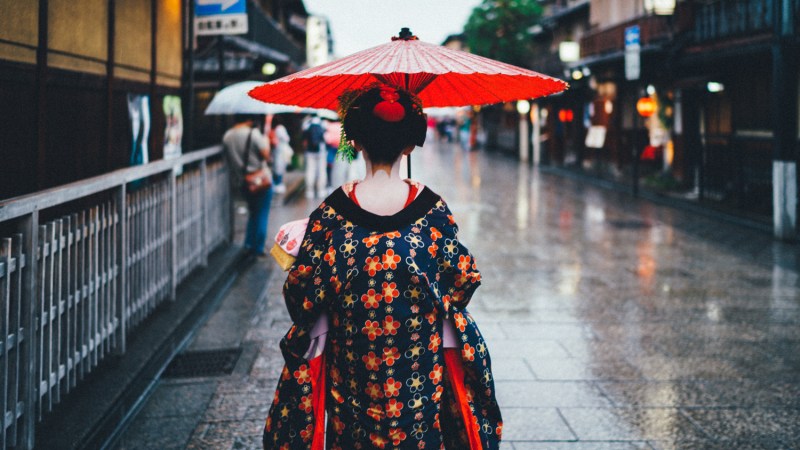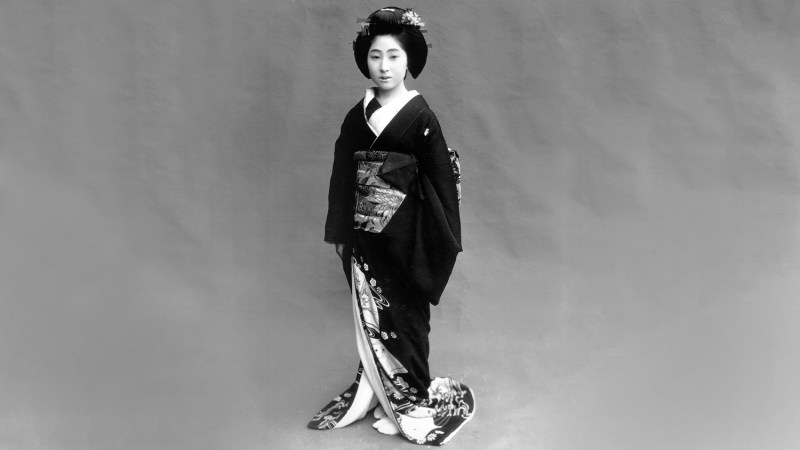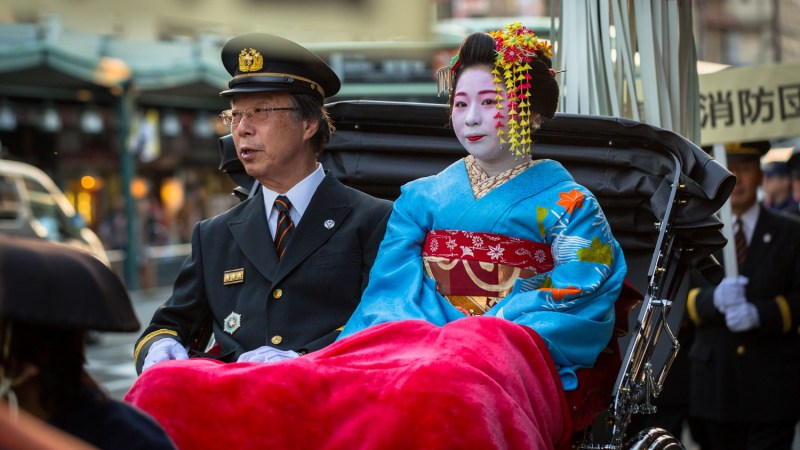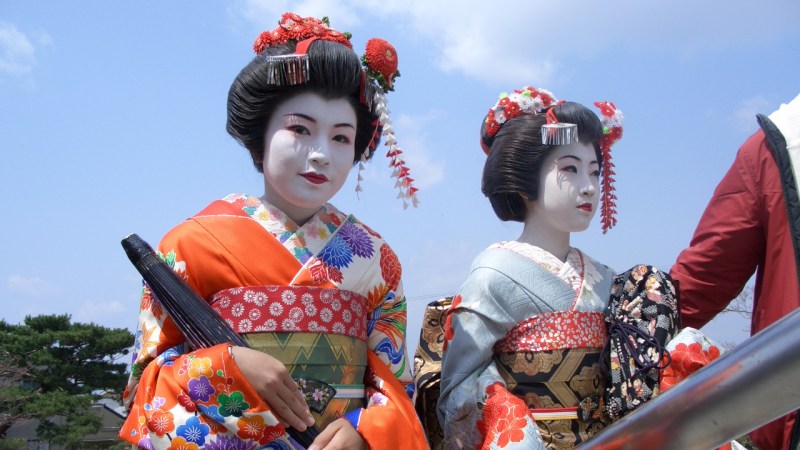

There’s really nothing in the West to equate them to: they are wholly of Japan. For centuries these women have been living art, the embodiment of Japanese culture, an iconic symbol, and a powerful ally that helped to topple the shogun.
The first geisha were actually men, a court jester-type character who entertained samurai and their courtesans over 1,500 years ago. The story goes, a courtesan found herself running low on customers and decided to become a geisha herself. She apparently started something of a trend. Another origin story, likely simultaneously true, points to the ochayas, or tea-houses during the Edo period (Edo is the former name of present-day Tokyo). They’d offer a traveler some tea and a bite, but as competition grew, they’d offer up dancing and singing, courtesy of girls in beautiful kimono to lure in customers.

Early on, courtesans had some reservations about these now-female geisha, worrying they would step on their professional toes, but the government regulated that geisha could not offer sex. Instead, geisha were companions, the ideal date. Their role as the epitome of art, grace, and wit endures to this day. Then, as now, she studies dance, music, literature and poetry. Her movements are carefully choreographed to enhance her grace. Specifically designed makeup enhances her beauty, but her greatest asset is her mind. It is imperative a geisha keeps the conversation lively and flowing; she ensures it’s interesting to the clients and she must be able to converse intelligently on any topic, from the weather to ancient poetry to sumo. Hell, they even play drinking games.
Geisha discretion is legendary. Their crimson lips are firmly sealed. Nothing said in their presence is ever repeated, which is perhaps why conspirators chose to plan the overthrow of the shogunate in favor of Emperor Meiji in geisha tea-houses. It’s not considered illicit or wrong to socialize with geisha, so there’s no need for secrecy on that account, but powerful, important men have always kept company with them and appreciate the ability to speak freely and openly in front of them.
Their beauty and delicacy belies the tenacity and toughness required to become a geisha. It’s a long, difficult road, and while the profession comes with many perks — meeting influential people, eating the best food, enjoying a certain level of fame — it can be a grueling life. Girls who choose to become a geisha usually start around 15, foregoing high school to seek training at an okiya, or geisha house. If accepted by the owner of the okiya, the okaasan, the geisha mother, the girl will work within the okiya and take lessons, forbidden from talking to her family or seeing friends. After about five months of daily chores and lessons — like the art of the tea ceremony or playing the shamisen — she takes an intense exam. If she passes, she becomes a maiko, a trainee. She will go out on appointments to banquets and tea-houses with her maiko sister, an older girl who’s meant to help teach and guide her. She and her sister are bonded for life in a deeply important ceremony. It takes five years of apprenticeship before she is considered a true geisha, or geiko, as is the term in Kyoto. Only half of maiko go on to become geisha.

It costs the okiya around $500,000 to train a new geisha, between food, lodging, classes, and the wildly expensive kimonos. Often, maiko are confused with geisha, but there are several ways to tell them apart. Generally speaking, maiko will be far more elaborately dressed, partly to distract from any mistakes they might make while in training.
Before each appointment, it takes about an hour to apply just the makeup. The pale-white face has a number of reasons: in days before electricity, it glowed in the candlelight, it represents purity, and it’s something of a mask, turning flesh and blood into an ideal. A distinctive double-v of naked skin is left at the nape of the neck, partly to give the illusion of a long, elegant neck, and partly to highlight the eroticism of the nape. Maiko paint their lips bright red (though maiko working less than a year only paint their bottom lip) to signify they’re not yet a mature woman.
About once a week, maiko will get their hair styled, sleeping on a block so as not to mess it up, and put ornaments specific to them in the elaborate coif, changing them to match the season. The heavy styles often result in a bald spot on her head, which is considered a badge of honor.
The iconic kimono has deep significance in Japan. Originally the uniform of samurai who wore it to show allegiance to their warlord, these garments are passed down through familial generations, but maiko kimonos are especially elaborate and unique. A man is needed to help dress the maiko because of how heavy the kimonos are. Their obi, the sash around their torso, is 23 feet long and tied in the back so the ends drape down. The obi also acts as a sort of back support. Kimonos, usually made of hand-painted silks and chosen by the geisha mother for each maiko, can cost thousands. Fully dressed, she could be wearing something like $30,000 in jewels and silks, all weighing roughly 20 pounds. Imagine wearing a restrictive, 20-pound outfit and being expected to have supernatural grace?
Geisha, on the other hand, generally do not wear the white makeup or their hair styled elaborately (they’re allowed to wear wigs). The lack of makeup denotes their maturity. Their kimonos will be far simpler and their obi will be tied short instead of having the long tails of a maiko. Deference is paid to a geisha when she comes to an engagement and maiko, regardless of what year they are in their apprenticeship, are expected to watch and learn from her.

Even once considered a geisha, her classes and education never stop. And there is no age limit. Some of Japan’s most celebrated geisha were sought after into their 80s, 90s, and even 100s. But they cannot marry. If they do, they must give up the life of a geisha. But, she may one day have a danna, a wealthy patron who will pay her living expenses throughout her life. It’s a real status symbol for a man to be a danna, but it does not necessarily mean the relationship is sexual.
Men and women generally don’t socialize in Japan. Things are certainly changing, but if men were out together and wanted female company, geisha were the answer. An engagement — of which a geisha or maiko might have two, three, or four a night — can cost hundreds of dollars an hour and usually includes a dance, singing, artful conversation, and sometimes drinking games, but geisha and maiko will not eat or drink unless asked to do so. Tea-houses arrange everything and are extraordinarily exclusive in terms of clientele, though even that is changing a bit.
If you want to see a geisha, your best bet is in Kyoto’s Gion district. They’ll start appearing from their okiyas around dusk to head out to engagements. Obviously, these are fellow humans, so if you want to photograph them, be respectful. One tip offered is to never get in their way, after all, they’re working. And try to only take their picture from the back, unless they’ve indicated it’s okay to do so otherwise. Many photography studios offer services where girls can dress up as geisha and have their pictures taken and walk around town. It’s easy to confuse them with the real deal, but you’ll likely be able to figure it out based on the look of the kimono, their demeanor, and the time of day you’re seeing them.
It’s far easier now for foreigners to experience dinner or tea with maiko or geisha, though it’s still very much about having the right connections, as well as deep pockets. Many high-end hotels or travel agencies can help arrange it. It’s expensive, but one of the most unforgettable experiences in the world — something truly unique to Japan.


